Learning Outcomes
After this course, learners will be able to:
- Describe how SmartCompress technology can control compression in speech-in-noise environments and control gain in non-speech environments.
- Explain how to manage acoustic feedback with the Adaptive Feedback Canceller Pro in Captivate hearing aids.
- List and describe the available features and technology in Sonics Captivate hearing aids.
Introduction
My name is Erin Reichert, and I am the Director of Professional Services at Sonic. Today, I am happy to introduce our newest product offering, Captivate 100, 80, and 60. Thank you for your time and attendance today. We will begin with a brief video on Captivate.
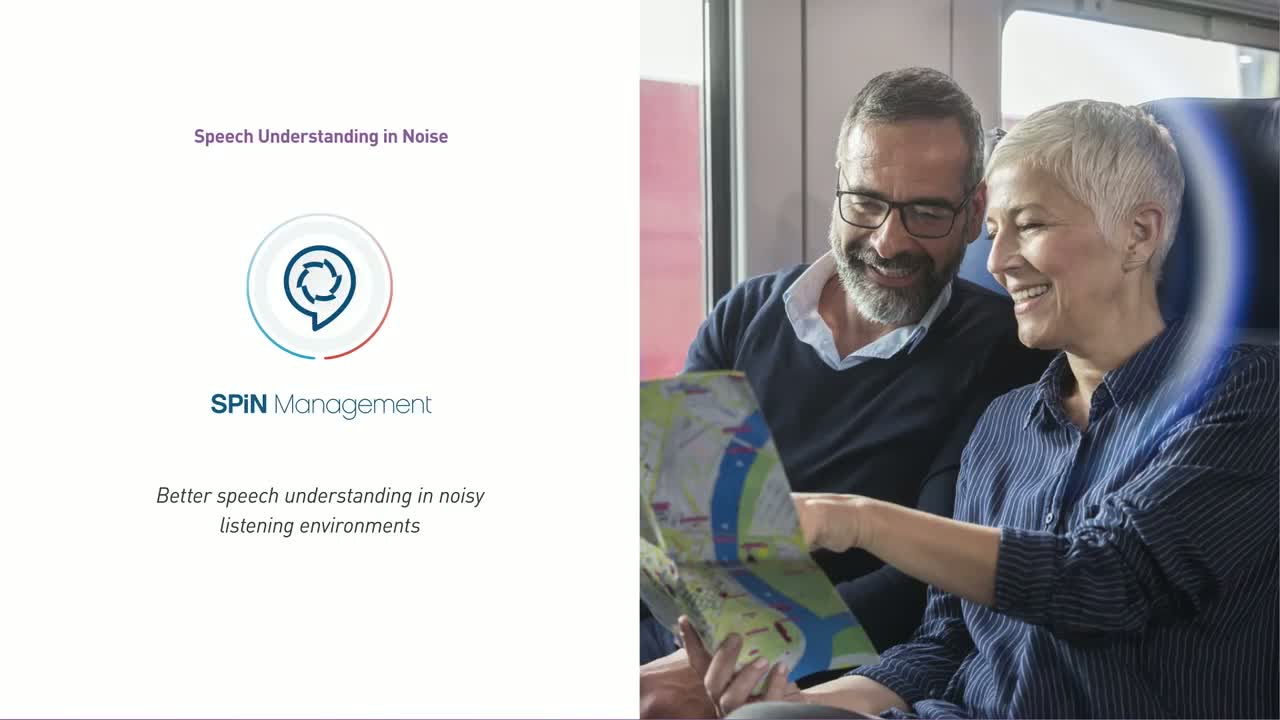
VIDEO TRANSCRIPTION: For over 20 years, Sonic has offered technology that brings the magic of everyday sounds and conversations to people with hearing loss, making their lives the richer for it. Now comes Captivate, what life sounds like, the most advanced realization yet of the Sonic 4S Foundation. Sound that's natural, speech understanding in noise, simplicity in everything we do, and style that stands out. Built on the SoundDNA platform, Captivate brings new capabilities that enhance the hearing experience. Our latest innovations include Adaptive Feedback Canceller Pro, eliminating feedback automatically so patients can live each day with fewer interruptions. And the miniRITE TR, with a built-in lithium-ion battery to power patients through a full day on a single charge, even while streaming audio. Charging is fast, reaching full capacity in three hours. The SoundDNA platform also features SmartCompress, an adaptive compression system that provides natural and detailed amplification, and more listening comfort. Speech variable processing works with SmartCompress to help patients hear speech and sounds in the environment with clarity. Our SPiN Management system highlights conversations while keeping distracting sounds to a minimum. Binaural Noise Management balances sound from side-to-side, to offset loud noises that affect one side more than another. And for patients who also suffer from tinnitus, a built-in system of broadband and nature sounds can help to provide relief from this persistent distraction. Captivate lets patients connect wirelessly to a vast array of music and entertainment. The SoundLink 2 app adds discrete control options from a smartphone, as well as "if this, then that" integration to connect hearing devices to other devices on the Internet of Things, while additional accessories add to the allure of Captivate. And with a rating of IP68, your patients can be sure that their devices will be protected against dust, sweat, and moisture. What's more, Captivate is available in a variety of models, technology levels, and colors. It all adds up to sound that's natural, speech understanding in noise, simplicity in everything we do, and style that stands out. Captivate, what life sounds like. Contact your Sonic sales representative to schedule a product demonstration today. With Sonic, everyday sounds better.
The current hearing instrument wearing population is more dynamic and more active than ever before. People are seeking hearing help at a younger age and being fit with devices. In order to truly help these patients and make their lives easier, we need to have the proper systems, tools, and processing capabilities in place to keep up with noisy and varied environments. This is where Captivate on the SoundDNA platform comes in to play.
Several years ago, we created what we call our 4S Foundation. Sonic is dedicated to improving life through enhanced hearing by constantly focusing on each of the components of the 4S Foundation:
- Sound that is natural
- Speech understanding in noise
- Simplicity in all we do
- Style that stands out
With Captivate, these four components add up to a better hearing experience.
Captivate
The SoundDNA platform is our revolutionary technology platform that we are introducing with the Captivate product offering. From clarifying conversation to streaming online entertainment, Captivate immerses patients in the sounds of everyday life.
For 2019, we have updated SoundDNA in many ways:
- More Processing Power
- New Algorithm (AFC Pro)
- New Setting (SPiN Engage Very High)
- New Feature (Li-Ion)
- New Benefits (Claims for SmartCompress and SPiN Management)
- More Robust Offerings Overall (Everything all together in 3 technology levels and various form factors)
If you haven't worked with Sonic, the most important thing that I want you to take away today is how we analyze and "attack" the signal, to make sure that our users have hearing experiences with high fidelity, natural quality signal. Within a hearing instrument, there are many things happening all at once. With Captivate, Sonic delivers a natural sound with several different layers of technology, including:
- SmartCompress
- Adaptive Feedback Canceller Pro
- Frequency Transfer
- Extended Dynamic Range
- SmartMusic
With all of these technologies combined, our users can listen with ease. We don't want our product to be a hassle. We don't want to provide a headache to our end users. Our goal is for users to be able to put in their hearing instruments at the beginning of the day and have things go as smoothly and as easily as possible all throughout the day. Captivate executes on this goal.
SmartCompress
The first layer of technology we will examine is SmartCompress. SmartCompress is a configurable, adaptive compression system for intelligent amplification in noise. SmartCompress is different than other systems in the marketplace, providing natural and detailed amplification for your patients. You may have two patients with the same hearing loss, but they may have different needs based on their lifestyle, the settings that they find themselves in and their dynamic range.
Hearing aids apply gain and compression based on the overall level, a manner that optimizes speech in quiet listening situations. It is a fact that hearing instruments are developed for speech-in-quiet listening conditions. However, speech in quiet environments, speech in noise environments, noise only environments and quiet only environments have very different characteristics. At Sonic, we believe hearing aids should not apply the same gain prescription in noisy environments as in quiet environments.
Listening environments are constantly and rapidly changing. A hearing aid must be able to accurately perform signal analysis, and then accurately amplify sounds of interest at a rate that keeps pace with changes. However, most gain prescriptions are designed for speech-in-quiet. Amplification is applied based on the overall level only, so it doesn't differentiate the type of the signal (speech level vs. noise level) and is optimized only for speech in quiet.
Sonic's most recent solution is to use Environment Classification. We use Speech Variable Processing (SVP) to apply amplification in speech-in-quiet. SVP measures and applies gain to the wideband acoustic signal. It does not break up the incoming signal separate frequency regions. SVP uses Phoneme Focus and Envelope Focus (tools in the EXPRESSfit Pro fitting system) to address auditory resolution needs. Furthermore, we have used Environment Classification to assist SVP in identifying al other changing environments.
For its time, Environment Classification did a pretty good job identifying the changing environments (speech-in-noise, speech-in-quiet, noise, quiet). However, Environment Classification uses static, or non-adaptive, rules to classify environments. As such, there are some limitations to Environment Classification. For instance, in rapidly fluctuating environments, changes in performance are rigid and slow (300-millisecond delay), resulting in imprecise hearing aid performance based on information from the past. If a patient was struggling in a noisy environment, it would require manual adjustment to a different program.
While SVP is optimized for speech in quiet, SVP with SmartCompress optimizes all other listening environments. SmartCompress allows the system to intelligently overcome challenges associated with a rapidly changing listening environments for a natural, instinctive hearing experience, eliminating the need for Environment Classification with SmartCompress. In the real world, our listening environment is ever changing. For example, we could be attending a meeting in a conference room with people around us having side conversations. We might be participating in a conference call on speaker phone and there may be static on the line. SVP with SmartCompress optimizes for all of these situations and delivers the solution on many different levels:
- It's effective: SmartCompress specifically addresses the problem of applying compression in noise.
- It's adaptive: An adaptive compression system overcomes limitations of a fixed Environment Classification system
- It works well with others: SmartCompress complements SVP, directionality and noise reduction, and any fitting rationale of your choice.
- It's accurate: SmartCompress precisely measures sound changes in the environment. It is able to detect the short-term SNR of the signal at phonemic speed, as well as detect the ongoing long-term SNR of the overall environment. This management of both short- and long-term SNR is what separates Sonic from our competitors.
- It discriminates: SmartCompress knows what is speech and what is noise.
- It's intelligent: SmartCompress applies different amounts of gain and compression on the signal target speech versus noise.
- It's fast: SmartCompress detects the SNR in real-time. It recognizes and addresses noise that occurs in between speech phonemes and speech pauses.
How does it work? SmartCompress uses two SNR level estimators, compared to one in traditional systems. In Figure 1, the green represents the fast phonemic estimator, and the blue represents the slow, long-term estimator. You can see that as noise is changing with speech, there are dramatic differences between green and blue. SmartCompress analyzes the signals simultaneously and provides an accurate measurement of environmental changes in real time.

Figure 1. Graphic representation of fast and slow/long-term estimators in SmartCompress.
SmartCompress controls compression in speech-in-noise environments, as well as adaptively varying the compression in speech-in-noise environments. It also determines how much the compression needs to be decreased, or made more linear, for less noise in the output. Furthermore, SmartCompress controls gain in non-speech environments. It adaptively limits gain when speech is not present, providing comfort to the patient. Sometimes, the noise floor or the overall amplification can be overwhelming. If your patient isn't comfortable with their hearing instrument, they're not going to wear it. SmartCompress controls gain in non-speech environments, adaptively limiting gain when speech is not present. It determines the occurrence of quiet and noise-only situations and applies less gain to the input to keep things comfortable. It's two systems working together.
In situations where there is a high signal-to-noise ratio, such as speech in quiet environments, SmartCompress does not activate. In those situations, SVP applies the prescribed gain and compression as designated by the selected fitting rationale, along with any fine-tuning actions made by the hearing care professional (e.g., Sonic's proprietary Best Fit Fast SE or NAL-NL2). However, in situations with a very low SNR (e.g., quiet and noise-only environments without speech), SmartCompress via the Gain Control applies less gain to the incoming signal. This offers greater listening comfort in non-speech listening environments. Finally, in environments with a moderately low SNR (e.g., speech-in-noise environments), SmartCompress via the Compression Control reduces compression. This minimizes the amplification of noise following short pauses in speech, or even between phonemes and improves the output SNR, supporting speech and listening comfort in complex environments. Gain Control and Compression Control are two systems that are available in the EXPRESSfit Pro fitting system (our fitting software).
At Sonic, we talk about our systems as being automatic, adaptive and flexible. SmartCompress is automatic, providing a robust analysis of environmental changes and reacting instantaneously, not based on rigid environment classification in rapidly fluctuating environments. SmartCompress is adaptive, tracking ongoing changes in SNR and using SNR information to guide the adaptive compression system. SmartCompress controls amplification based in the signal type and intelligently adjusts the gain. Finally, SmartCompress is flexible and is easily personalized for individual needs in the fitting software. If you are interested in learning more, visit our new website (www.sonici.com) and read our updated spotlight paper on SmartCompress, which includes a lot of clinical data that support this new system.
Adaptive Feedback Canceller (AFC) Pro
With our new Adaptive Feedback Canceller, we have made huge strides in feedback cancellation. AFC Pro has a new algorithm exclusive to our 2019 products on the SoundDNA platform (namely Captivate). It is one feedback management system with two separate technologies.
The main advantage points with AFC Pro include the following:
- Fewer distractions and interruptions from the annoyance of feedback in both stable and changing conditions
- Improved audibility of soft speech sounds, for a better target match
- More open fittings for a natural, own-voice sound
With regard to feedback management, we have three simple goals: to decrease the occurrence/annoyance of audible feedback, to maintain speech intelligibility, and to have successful open fittings with a high-quality signal.
AFC Pro is an adaptive phase cancellation system combined with a new second anti-feedback system, called STM Processing. STM stands for spectro-temporal modulation. This new technology is designed to attenuate feedback from fast-changing conditions. Spectro-temporal modulation is an added signal that attenuates the feedback path. Applying this added signal prevents feedback from occurring. STM Processing replaces traditional loud and annoying feedback whistling sounds with soft and non-intrusive STM processed sounds, which most hearing impaired people don't even hear (Guo and Kuenzle, 2017).
When using STM processing, an extremely fast adaptation to changing feedback paths is achieved. STM Processing briefly provides a modulated signal back to break the feedback loop and suppress feedback. In fact, we can provide an additional 6 dB of gain before feedback. The small application of STM may be perceived by some listeners as a slightly noticeable soft, non-intrusive sound, however, that brief signal is much less annoying than the whistling of a loud feedback signal.
In 2017, Guo and Kuenzle conducted some studies using STM processing. In the spectrogram in Figure 2, we can see some examples of the hearing instrument used with a phone. The top picture is without STM engaged. You can see that the feedback magnitude is strong, represented by the dark blue, versus the rest of the signal (light blue). In the bottom picture, STM is engaged. The STM signal magnitude is very low, represented by the light/white color.

Figure 2. Spectrogram representations of feedback with STM not engaged (top) and STM engaged (bottom).
The conclusions that Guo and Kuenzle reached are as follows:
- Conclusion 1: A new method of assisting the adaptive filter for feedback cancellation in hearing aids was proposed. STM processing is applied whenever the adaptive filter is insufficient to cancel feedback. If our inverse phase canceller (that's already working automatically) can't maintain sufficient feedback cancellation, STM comes to the rescue.
- Conclusion 2: Using STM, feedback cancellation performance in very challenging dynamic situations during rapid feedback path changes is improved, without changing the feedback performance in other situations.
- Conclusion 3: Simulations showed that in a hearing aid system with rapid feedback path changes, the traditional adaptive filter method failed to cancel feedback and annoying whistling sounds appeared, whereas the proposed method is able to keep the hearing aid system stable and thereby avoid feedback whistling sounds.
Figure 3 shows the adaptive feedback canceller block diagram. Two traditional microphones pick up the sound. The first block processes the microphone signal (including directionality noise reduction). The existing anti-feedback system then estimates the feedback coming from the output to the input, resulting in a problematic path. Finally, the estimated feedback signal is subtracted from the microphone signal to cancel feedback. That's the inverse cancellation system.
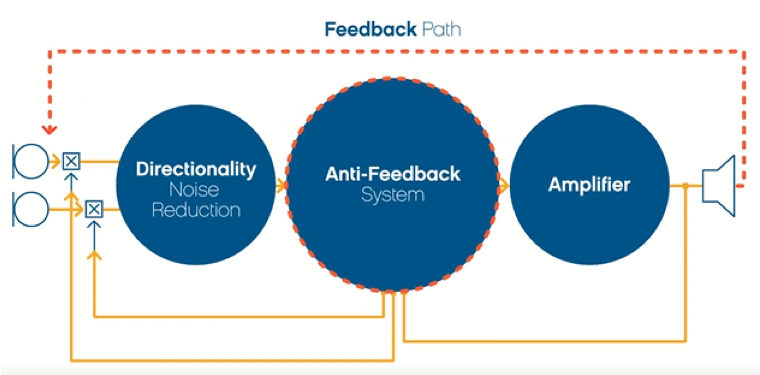
Figure 3. AFC block diagram.
With our AFC Pro, we have the new "add on" STM processing component which overrides the existing anti-feedback system. When it's activated, it removes the feedback, replacing it with STM sounds (i.e., a non-offensive signal). The existing anti-feedback system operates in the background. The amplifier block provides the gain and compression, according to the hearing loss and the rationale, and then the receiver plays the processed and amplified sound.
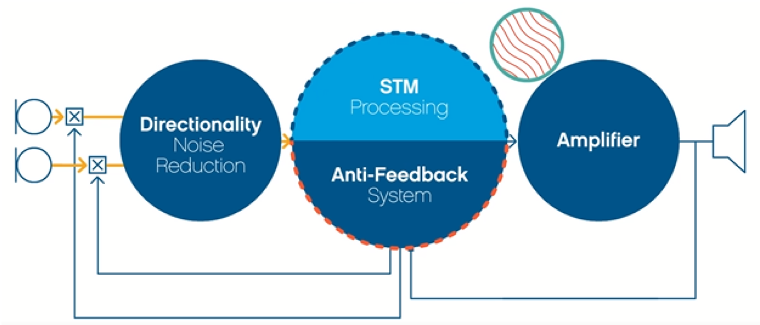
Figure 4. AFC Pro block diagram.
When you are in EXPRESSfit Pro fitting software, AFC Pro is on by default. The feedback manager screen that you will see in the EXPRESSfit Pro is unchanged. There's nothing you have to do differently for this new feedback cancellation system. It is very user-friendly and there is nothing different for your patient to experience.
Within EXPRESSfit Pro, there is a comparison view available in the Transfer Setting screen. This is where you can see a comparison between AFC and AFC Pro (Figure 5). You can see that there is a dramatic difference in the predicted feedback between Enchant (top) and Captivate (bottom). You have a much higher feedback margin for your Captivate instruments.
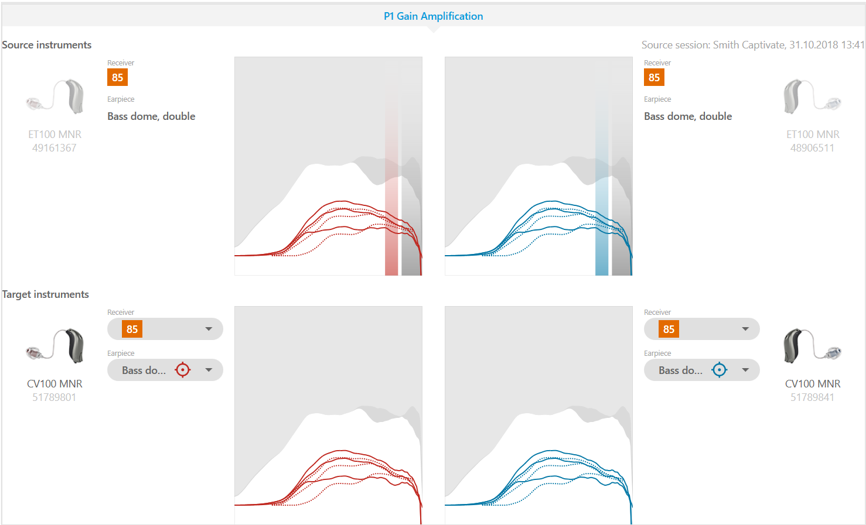
Figure 5. AFC vs. AFC Pro.
When we take a closer look at acoustics (Figure 6), AFC Pro provides a better target match for Captivate at soft and medium inputs in HFs, resulting in a 6 dB added stable gain (ASG). This means that a higher number of patients can be fit for better audibility with less risk of feedback. With Captivate, we're able to provide a positive impact on the fitting range and the headroom of that product, making your patients happier and more comfortable.
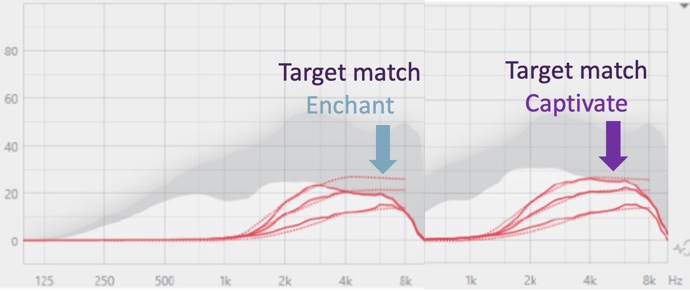
Figure 6. Target match of Enchant vs. Captivate.
To reiterate, AFC Pro is not active when there's no feedback occurring. But, if AFC Pro needs to engage because our traditional adaptive feedback cancellation system needs some help, it will engage accordingly.
Remember our three simple goals for feedback management:
- Decrease occurrence/annoyance of audible feedback.
- Maintain speech intelligibility.
- Successful open fittings that provide high fidelity and natural sound quality.
Now, we will view a video that will summarize everything I just discussed.

VIDEO TRANSCRIPTION: The Sonic SoundDNA platform makes every day sounds better, with Adaptive Feedback Canceller Pro. Called AFC Pro, this innovative feature uses two anti-feedback technologies to create one proficient system. Let's see how they work together to reduce the risk of feedback.
When an incoming sound reaches the hearing aid's microphone, it gets amplified and sent through the receiver into the ear. Sometimes the microphone picks up the amplified sound after it's left the receiver. That sound is amplified another degree, and the process repeats, turning the sound into an unpleasant squeal called feedback. That repeating cycle of sound between the receiver and microphone is called the feedback path.
Sonic's adaptive feedback canceller already monitors signals to see if they've been amplified before. If so, the anti-feedback system estimates the sound's feedback path and sends a counter signal to cancel the repeated sound. This breaks the feedback path. This system works well in stable situations when it can estimate a sound's feedback path, then match it to the actual feedback path in the ear canal. However, feedback can also occur when the feedback path is more unpredictable. Quick movements near the hearing aid, like putting on a hat or making adjustments to the device, can also trigger feedback. In these cases, the system can't respond fast enough, and the estimated feedback path doesn't match the real feedback path. Sounds that fall outside the predicted feedback path are picked up from the receiver and start to amplify.
SoundDNA with AFC Pro now includes a second system to control feedback from rapidly changing feedback paths. This new approach is called spectro-temporal modulation, or STM processing. As sound enters the hearing aid, STM processing detects feedback from dynamic conditions and applies momentary attenuation only in the specific frequency bands of the feedback. The STM system rapidly eliminates feedback signals from dynamic conditions, while the traditional anti-feedback system cancels feedback from static conditions. Together, these two systems are called AFC Pro.
Let's compare graphs with and without this technology. Here is a spectrogram of a hearing aid's output without AFC Pro. The acoustical feedback is shown in red. This spectrogram shows the same hearing aid's output with AFC Pro. The acoustical feedback that was in red is gone. With the new technology, nearly all audible feedback from the output has been eliminated. AFC Pro removes offending feedback signals often before they are even heard. The patient enjoys a reduced risk of feedback.
AFC Pro is easy to use in the fitting software. First, place the hearing instruments in the client's ears correctly, and ensure background noise is not present. Click "measure" to run the measurements, then choose "accept" to apply the measured feedback margins. Listeners will appreciate the advantages of this two-in-one system. AFC Pro means fewer distractions from the annoyance of feedback, whether in stable or changing conditions. Soft speech sounds are more audible for a better target match. And because it reduces the feedback that can come from motion near the hearing instrument, AFC Pro delivers more open fit possibilities. Listeners can hear the sound of their own voice in a more clear and natural way. With the advanced feedback management system of AFC Pro, patients enjoy a truly individual hearing experience. The SoundDNA platform is one more way Sonic technology makes everyday sounds better.
Frequency Transfer
Our frequency lowering technology called Frequency Transfer is available in the EXPRESSfit Pro fitting system. Frequency Transfer helps to identify consonants for patients that have severe high-frequency hearing loss and then transfer it to a different region. Within 10 different destination regions, Frequency Transfer adjusts the high-frequency source and the low-frequency destination regions. We offer seven intensity settings, and then we also have a high-frequency attenuation, turning the gain in high-frequency bands above the destination on and off. These are all configurable in the EXPRESSfit Pro fitting system.
Extended Dynamic Range (EDR)
Extended Dynamic Range is a premium level feature in the Captivate 100 to keep loud sounds clear in challenging listening environments. EDR is specifically designed for signals with high intensity in loud situations, such as a concert or a sporting event. EDR is a great feature for a hearing aid wearer who is active, because they will not only be comfortable, but they will also be able to hear signals with incredible fidelity. Listening environments with speech can get loud and quickly change in intensity. The presence of loud speech signals can have peaks that exceed 95 dB A. Most hearing instruments on the market have limits at 95 dB SPL, which may result in distortion. The Captivate 100 adaptively extends the dynamic input range and expands to growing sound levels only when needed. Our upper limit depends on the input level of the speech signal, anywhere from 95 to 113 dB SPL. As needed, Captivate 100 allows those loud peaks to be amplified with less risk of distortion.
SmartMusic
Music a universal joy, but if a music enthusiast is unable to listen to music loudly, or if it sounds garbled, that can be frustrating and disappointing. A lot of music enthusiasts struggle with amplification, except when they're using our products with SmartMusic. Many music enthusiasts and musicians associate our instruments with being able to hear clear sounding music again.
SmartMusic is optimized for attending indoor and outdoor live concerts. It consists of four components that make it unique.
- Fixed Extended Dynamic Range: Fixed EDR increases the limit at the input to a fixed 113 dB SPL.
- Speech Variable Processing: SVP maintains the balance between harmonics.
- Wideband Frequency Response: This is a key element for the perceived naturalness of music.
- Controls (e.g., a fixed hypercardioid polar setting and unchanged position of null) that eliminate noise from behind so the wearer can focus on the target signal (i.e., what's on stage):
Speech Understanding in Noise: SPiN
With Captivate, Sonic delivers what life sounds like in noise. We provide great sound quality in noise with a variety of systems and features, including:
- SPiN Management
- Binaural Noise Management
- Relief from Distractions
- Impulse Noise Reduction
- Soft Noise Reduction
- Wind Noise Reduction
- Tinnitus SoundSupport
SPiN Management
The best thing we can do for our patients is to improve the SNR. Poor signal-to-noise ratios are a problem when you have a hearing loss. Historically, we have used directional microphones. D mics make a big difference, but so does digital noise reduction (DNR). Sonic's SPiN Management system offers a completely new automatic, adaptive, and multiband design to enhance speech, reduce noise and optimize the control of it all. This is achieved through a trio of technologies working together:
- SPiN Directionality
- SPiN Noise Reduction
- SPiN Engage
On our previous platform, directionality and noise reduction were uncoordinated before SVP amplified the signal. Now with SoundDNA, SPiN Directionality and SPiN Noise Reduction is coordinated together via SPiN Engage to deliver a natural sound experience. In 2019, we have updated SPiN Engage with a new "Very High" setting. The Very High SPiN Engage setting is only available in the Captivate 100.
SPiN Management has made a big difference for our Enchant wearers, and now with our new very high setting with SPiN Engage, it makes things that much better, especially for new users that are very sensitive to noise. Hearing aid users have varying tolerance limits regarding how much noise they are willing to accept. SPiN Engage allows personalization based on each patient's individual needs and preferences. SPiN Engage coordinates the onset of SPiN Directionality and SPiN Noise Reduction as the SNR fluctuates in 16 independent frequency bands. For an active person who experiences a lot of different listening environments, it's important to give them a product that's going to deliver excellent sound quality in noisy environments, especially for someone with a reduced dynamic range.
SPiN Engage offers up to four settings that correspond to the level of help your patient needs or prefers in changing listening environments. As the hearing care professional, it is important to determine your patient's tolerance for noise to provide them with the best settings. For patients that are distracted or disturbed in speech-in-noise settings (e.g., new hearing aid wearers), set SPiN Engage at the Very High setting to quickly put an emphasis on the speech signal. There is also a High setting available. For experienced hearing aid wearers who accept more noise and prefer auditory awareness, they will benefit from a medium or a low setting because for them, that's a major component of auditory awareness.
Binaural Noise Management (BNM)
We have two ears but we hear with one brain. We need to make sure we support our patients who encounter situations with distracting, uneven noise from side to side. A perfect example of this type of scenario is if you are driving in a car with the windows open, the radio playing and passengers talking in the back seat. Anytime we have uneven and unbalanced hearing environments, we naturally focus our attention to the better side and actively mentally suppress the noise on the opposite side to take advantage of the better audibility in one ear.
Binaural Noise Management activates when the noise level becomes significantly different between the two ears. It shifts the hearing instrument response into a mode that fully activates the NR system on the side with excessive noise. It uses wireless technology to offset unpredictable noises that affect one side more than another. BNM analyzes each hearing aid and automatically applies the optimum noise reduction setting. Wireless communication between devices is automatic for an immediate response.
Binaural Noise Management is a feature that is available in our premium and advanced level technologies of our Captivate 80 and 100.
Relief from Distractions
Let's face it -- no one wants noise. Sonic offers three systems to alleviate unwanted noises. First, we have Impulse Noise Reduction, which lessens the discomfort of sudden, loud sounds (e.g., clapping hands, clanging dishes, jiggling keys). Our technology offers Impulse Noise Reduction because we believe in making sure our patients are all comfortable in their hearing instruments. Next, we have Soft Noise Reduction to reduce low-level noises without affecting speech. In the hearing aid industry, there are a lot of systems to keep low-level HVAC systems at bay, but unfortunately, they end up attenuating speech signals. It's important to have a system that properly detects and preserves speech. Finally, we offer Wind Noise Reduction which adjusts to outside activities by monitoring the environment and preventing the rush of wind from being amplified.
Tinnitus SoundSupport
I personally have tinnitus. It can be very frustrating. There are a lot of people that struggle with tinnitus and they don't know what it is. Now, we offer Tinnitus SoundSupport in our Captivate instrument. It's available in all technology levels of Captivate. It aims to reduce your patient's perception of their tinnitus by providing amplification and generating some sound relief. We have four different broadband signal options (white noise, pink noise, red noise and shaped to audiogram) and three different nature-like signals (Ocean 1, Ocean 2 and Ocean 3). Broadband sounds are the most commonly used in tinnitus therapy. Broadband sounds have stable and neutral characteristics. They don't attract a lot of attention. They are not annoying and do not provoke a negative reaction. Nature sounds, such as water and ocean sounds, can have a positive, emotional effect on people. Whenever I'm near an ocean, or even a lake or a river, water sounds are quite peaceful. They can provide a rhythmic and soothing sound, allowing people to feel less stressed and more relaxed.
The Sonic SoundLink 2 App allows users to control their tinnitus sounds. They can also use the app to adjust tinnitus volume, mute, and modify the signal. The app is available at the App Store as well as Google Play.
Captivate: Solutions That Make Sense
With Captivate, we are offering solutions that make sense, including:
- Lithium-ion Rechargeability
- Dual-Radio System
- If This Then That
- Low Frequency Enhancement
- Binaural Coordination & Synchronization
- EXPRESSfit® Pro
Lithium Ion Rechargeability
With Captivate, we have a new lithium-ion rechargeable battery solution. It has a robust battery life capacity for a full day's use following a short charging time. We have a brand new model called the miniRITE T R (the T stands for telecoil; the R is for rechargeable). It will be available in all Captivate levels (Figure 7).
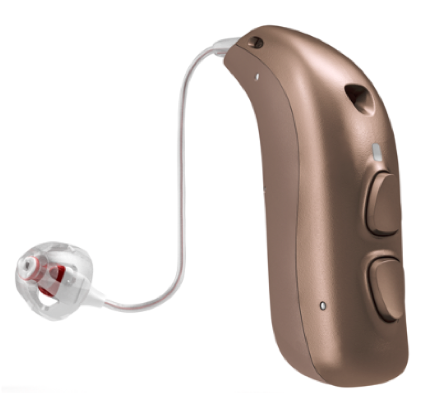
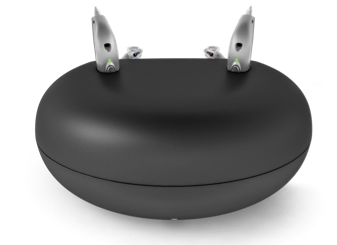
Figure 7. Captivate miniRITE T R and charger.
It offers a 312 lithium-ion rechargeable battery. For our end users, it's a fully featured hearing aid in a stylish package with longer wearing time and shorter charging time. In fact, 13 minutes of charging charges the device to 25% battery capacity. Sixty minutes of charging gives you 50%, and three hours gives you a full day's charge. For clinicians, this device meets the market need for a lithium-ion rechargeable solution.
The Captivate miniRITE TR is small and stylish. It's a RITE product that is very similar to the miniRITE T that we have offered with our Enchant model. We have the miniRITE T as well for the Captivate product. It includes telecoil. It also includes a dual push button. We have different receiver strengths to suit mild to profound hearing losses.
The charger has inductive technology that allows contactless charging of the hearing instrument via induction coil. That translates to no worries about corrosion. There's also a magnetic connection in the charger to prevent the hearing instrument from falling out of the charger if tipped over. When the hearing instruments are inserted into the charger, it automatically starts charging. Plus, the hearing instruments automatically turn on when they are removed from the charger. For more information about lithium-ion technology, we will be offering a new course on AudiologyOnline dedicated to explaining more about our rechargeable solutions.
Dual-Radio System
In this day and age, everything is connected to everything. Wireless connectivity is a way of life for today's hearing aid users. To be competitive in the hearing aid industry, you have to have a system that can handle a lot of different environments.
With our SoundDNA chip, there are three benefits that we want to discuss when it comes to our dual-radio. We have our Bluetooth 2.4 GHz communication coupled with our near-field magnetic induction protocol (NFMI). NFMI is used for short distances (i.e., ear-to-ear). The 2.4 GHz is used for longer distances. This results in dual-radio transmission without a significant increase in power consumption, which is important, especially when it comes to lithium-ion. Furthermore, we have an incredibly high transmission rate of sound data which gives that natural sound quality, even while streaming. Finally, we have the 2.4 GHz direct-to-ear streaming (i.e., an intermediary device is not required).
In Figure 8, we can see all of the offerings in our SoundDNA connectivity portfolio.
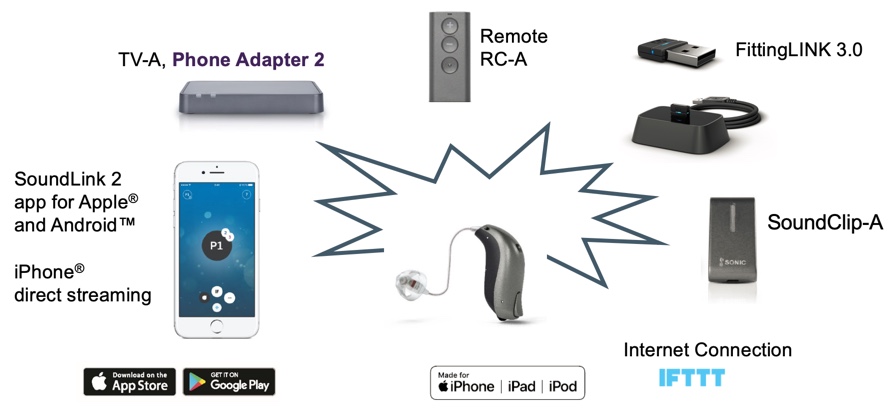
Figure 8. SoundDNA Connectivity Portfolio.
The SoundLink 2 app is available at no cost at the Apple Store, as well as for Android on Google Play. If you're using an iPhone, you have direct streaming. The SoundClip-A allows streaming to happen via Android devices. We offer support for our FittingLINK 3.0, but we also support the NoahLink Wireless. We do have a remote control which is called our RC-A that is compatible with the Captivate hearing instruments. Where we see the most use of the RC-A is with caregivers who are manipulating or changing programs on hearing instruments for someone in a care facility, for example. We do offer a TV-A and Phone Adapter 2. They are two different boxes and are labeled differently, but they look very similar. Captivate hearing instruments will work with a landline system using the Phone Adapter 2, but also requires the 2.4 GHz SoundClip-A to stream the landline call directly to the hearing instruments.
We have made some updates to our SoundLink 2 app. The battery level indicator is now shown in a percentage. If you're using the miniRITE TR model with a rechargeable lithium-ion battery, it will display the battery level in 1% increments. When using a standard zinc-air battery, it'll display the remaining battery live in 10% increments. In addition, hearing aid renderings in SoundLink 2 have been replaced by pictograms.
IFTTT: If This, Then That
In this technology age, we need to be smart. If This Then That (IFTTT) brings the Internet of Things to Captivate. When we first launched Enchant, which deployed our first introduction to the IFTTT world, there were about 300 internet-connected devices out there. Now, there are over 550 internet-connected devices and services, with more things being added to these platforms every single day. Many companies are introducing an array of options and technologies to make a difference for people that use smart technology.
How does this work? Figure 9 shows a diagram to help explain the process. The Captivate hearing instruments are connected to the smartphone, and the smartphone is then connected to the internet. The IFTTT is a service to connect to applications (e.g., Twitter, Facebook, etc.). It's not that the hearing instrument is directly connected to the cloud. The instrument goes through the smartphone, the app itself, and that is what's connecting to your IFTTT service.

Figure 9. Flow chart of the IFTTT process.
Our hearing instrument, Captivate, works with the GO service, which is the interface between Captivate and other services in IFTTT. Our SoundLink 2 app is developed by our Research and Development team. When you download the app, you can have a demo mode to become familiar with it. If you are interested in learning more about IFTTT, we offer a 30-minute spotlight course that goes into more detail about IFTTT, as well as the Internet of Things and how our instruments work with technology. If you have any questions on this, I encourage you to reach out to our audiology services team.
Low Frequency Enhancement (LFE)
When you are streaming, if you're using an open fit, those low frequencies have a tendency to escape. That's why people will sometimes describe the signal as sounding "thin". Often, the nature of open fittings is lack of bass. With low-frequency enhancement, it gives the effect of turning up the bass when streaming audio, to give it more of a robust, rich signal.
You can access LFE in the Accessory Tuning screen in the EXPRESSfit Pro fitting system. There are three levels to choose from: low, medium or high. LFT is only available for the Direct Audio Streaming via the TV adapter, your smartphone, or SoundClip-A. LFE is available in the Captivate 100, 80 and 60 levels.
Binaural Coordination and Synchronization
We live in a world where binaural coordination and binaural synchronization are very important. We need our two ears working as one. We have two ears, but we hear with our brain. Binaural Coordination provides the natural listening experience that patients desire to automatically share information between the left and right ears. This works so well that patients often forget they're wearing devices. Binaural Synchronization enables volume and program changes made to one ear to be simultaneously made to the other ear. If you're adjusting something on your app, if you're adjusting with your RC-A, when you make an adjustment, it's going to happen binaurally because that's what would occur in a natural listening environment.
EXPRESSfit Pro
The EXPRESSfit is software is very user-friendly. We have new features available with EXPRESSfit Pro19.1.1. These features include:
- Support for our new Captivate products
- Updated transfer fitting feature
- Improvements to our algorithm with Best Fit Fast SE
- Updated SPiN Management features
- New battery life status feature for lithium-ion rechargeable situations
We also still deploy Adaptation Manager. We still have our Real-Ear Fit integrated systems, as well as SoundStudio and NoahLink Wireless capability. For more information on the EXPRESSfit Pro fitting system, we offer an additional course on AudiologyOnline.
Style That Stands Out
We have four models available with the Captivate launch: the miniRITE, the miniRITE T (telecoil), the miniRITE T R (with telecoil and rechargeability), and our BTE 105 (Figure 10). These four different models are available in three performance levels: Captivate 100 (our premium level offering), Captivate 80 (our advanced level), and Captivate 60 (our mid-level). With each of these price points and performance levels, we have something to offer all of your patients. We also have seven color options available (beige, taupe, brown, gray, dark gray and black). Gold is only available in the miniRITE Captivate 100.
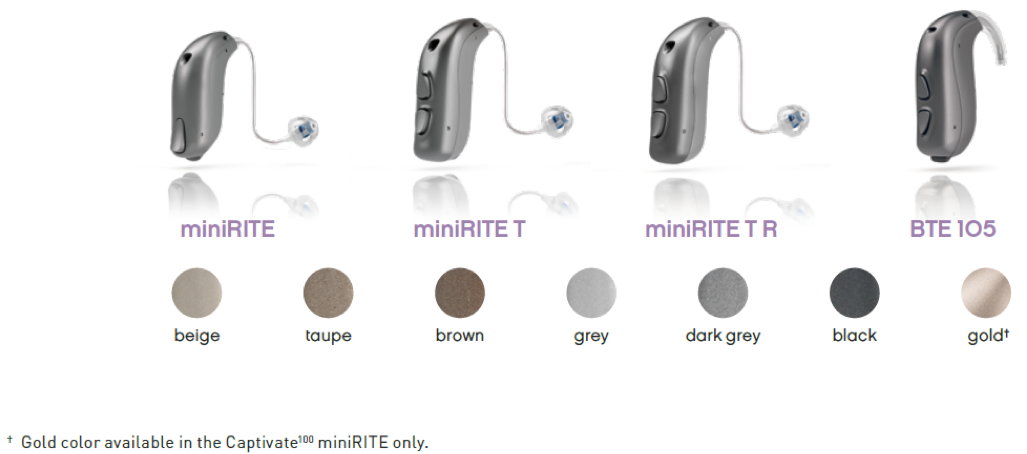
Figure 10. Captivate models and colors.
Design is in the details of Captivate. Figure 11 outlines many specific details about Captivate. If you have a hard time seeing this image, it is also available in our marketing materials that you can find on our website.
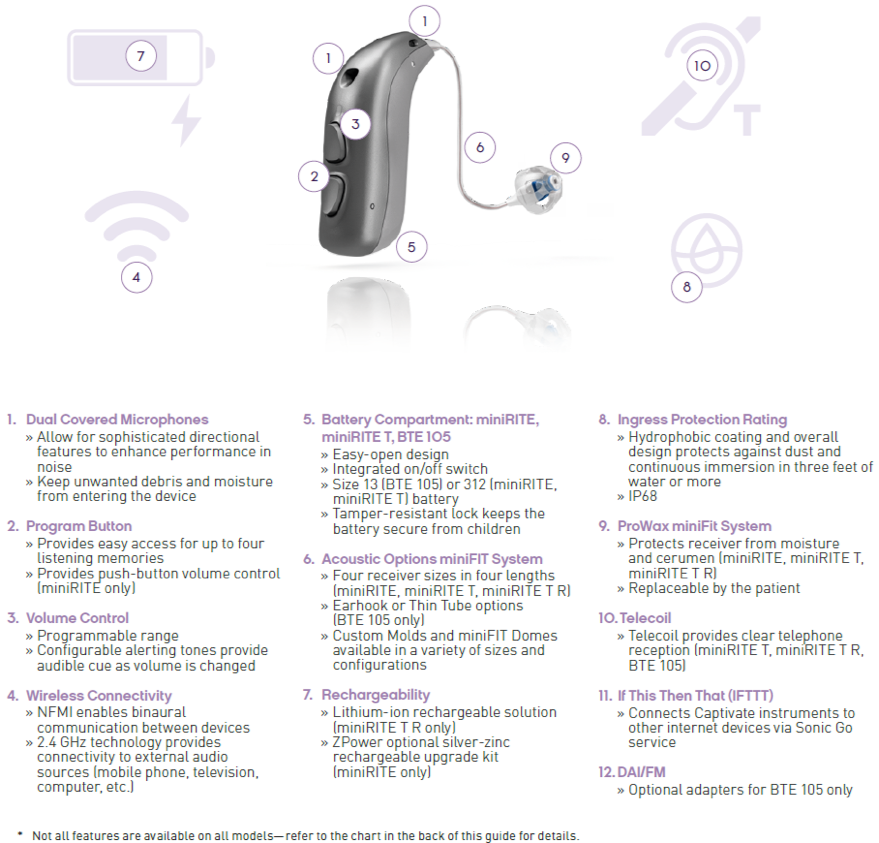
Figure 11. Details of Captivate.
This slide is fairly self-explanatory, but I wanted to highlight a couple of features about this product. Captivate offers an IP68 rating in all of our products. The hydrophobic coating and overall design protect against dust and continuous immersion in three feet of water or more. These hearing instruments don't rust out; they don't have corrosion issues. They are incredibly robust. I'd also like to highlight our ProWax miniFit system, which protects the receiver from moisture as well as cerumen. It is easily replaceable by the patient (if they don't have dexterity issues).
When you take a look at the model overview (Figure 12), you will see that there's a 312 battery in the miniRITE and miniRITE T. It also shows a 312 for the miniRITE T R, but that's a 312+. It's not a battery that you could go buy at your local battery store or order online. It is a battery that you can only receive from Sonic. The BTE 105 has a size 13 battery. We do offer power models. The 105 receiver is available with the miniRITE, miniRITE T, and miniRITE T R. We have volume control capability across the board. The only one without a telecoil is that miniRITE, the smallest instrument. Again, we have four different receiver sizes (60, 85, 100 and 105). The ear hook and thin tube configuration is available on the BTE 105. All models have the IP68 rating.
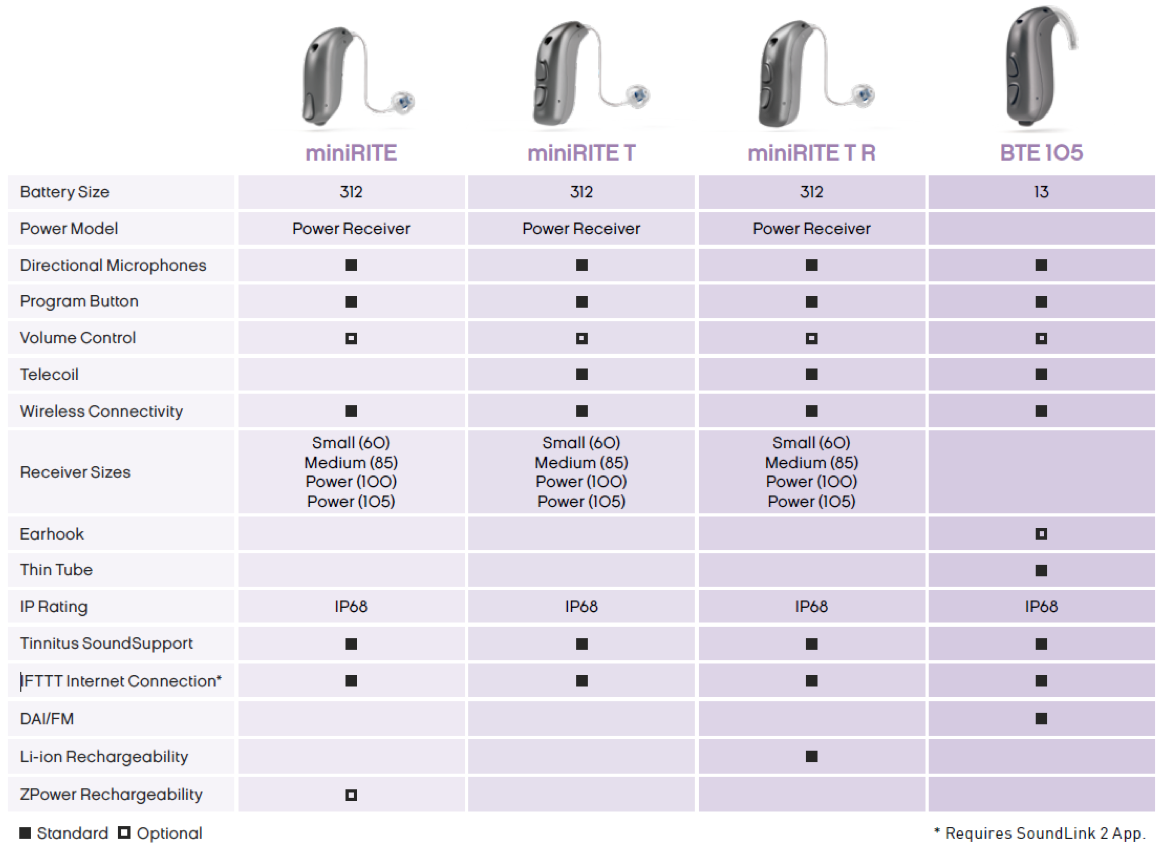
Figure 12. Captivate model overview.
Tinnitus SoundSupport and IFTTT are available in all models and all price points. DAI/FM is only available on the BTE 105. Lithium-ion rechargeable is still available only on the miniRITE T R. We still offer ZPower flexibility, for those of you interested in a ZPower rechargeable solution. ZPower is only available in the miniRITE model.
Summary and Conclusion
In summary, Sonic's 4S Foundation is truly what brings Captivate to market:
- Sound that is natural
- Speech understanding in noise
- Simplicity in everything we do
- Style that stands out
Our 4S Foundation grounds us in what we do with the development of the physical product, and with the development of all the training materials.
There is so much more to learn about this product. Today is just the first preview course. We also offer other courses on AudiologyOnline, including one on the EXPRESSfit Pro fitting system, as well as courses related to rechargeability and the Adaptive Feedback Canceller Pro. We also have spotlight papers and a lot of other content for you to learn more about Captivate.
Sonic's mission is to improve lives through enhanced hearing. We can only fulfill our mission through you, our hearing care professionals. With Sonic Captivate in your practice, you will have very happy patients.
If you have questions about any of this content, feel free to reach out to me (Erin Reichert) or anyone here in the audiology team. Our phone number is 888-423-7834. We will be happy to assist you. Our new website is also a great resource (www.sonici.com). Thank you for your time and attention today.
Citation
Reichert, E. (2019). Captivate- what life sounds like. AudiologyOnline, Article 25238. Retrieved from https://www.audiologyonline.com

